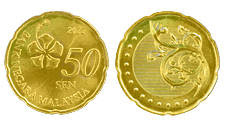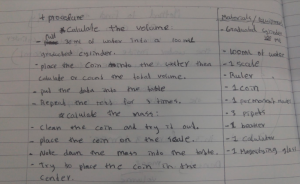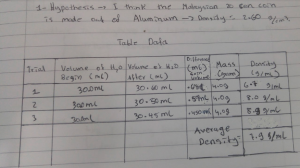Lab Report:
Title: What is the Metal type of the Malaysia 50 Sen Coin
by Mengthong Long
Introductory Chemistry
September 4, 2018
Abstract
The coins were introduced as a method of payment around the 6th or 5th century and from that time different countries tried to invent a different style of the coins for their currency. In the contemporary world, we still use the coin as our payment methods and those coins are made out of different metals types such as copper, aluminum, gold, silver, iron, nickel and many more. In this lab, it was set up for figuring out the Malaysia 50 Sen coin metal type. To do this, knowing the density of the coin was essential. So there were two main steps, first was to calculate the volume of the coin and then calculate the mass of the coin. Our results showed that the average density of the Malaysia 50 Sen coin was 7.9 g/ml and the coin was made out of a Gadolinium but compared to the actual data the coin was actually made out of a Brass Nickel.
Introduction
Coins are very important and necessary for many countries for their payment system, they use the coins as money in everyday transactions and exchange. There are many styles of coins that are made out of different metals depending on their value and each country preference. The basic of the coins are usually disc-shaped with different sizes and designs.
The main purpose of this experiment was to figure out the Malaysia 50 Sen coin metal type. Before the experiment, the hypothesis was that the Malaysia 50 Sen coin was made out of an Aluminum since the mass of the coin was light so its density wouldn’t be that much either, therefore, Aluminum was the choice based on the mass and observation.
Materials and Methods
In the experiment, there were two main steps, first was to calculate the volume and the second was to calculate the mass of the coin. At first, grabbed the 100 ml graduated cylinder and fill it with 30 ml of water. For this step, make sure that the lower curved surface of the water was in the same level of 30 ml, not surface due to the design of the graduated cylinder at the bottom surface. After the water was on the mark, slowly placed the coin into the graduated cylinder then note down the total volume into the table data. Finally, repeat the same steps for three replications for precise data. Then clean up space, especially, tried to clean and dried the coin properly so that it wouldn’t affect the mass result. Next, get the coin and tried to place it on the center of the scale. Lastly, note down the mass into the table data and repeat this process for three replications.
Results
Table: Calculate the average density of the Malaysia 50 Sen coin
As a result, the density of the first, second, and third replications was 6.7 g/ml, 8.0 g/ml, and 8.9 g/ml respectively. The average density of the Malaysia 50 Sen coin was 7.9 g/ml and based on Engineers Edge Densities of Metals and Elements Table, the coin was made out of a Gadolinium metal type.
Discussion
The result didn’t support the hypothesis, the hypothesis was that the Malaysia 50 Sen coin was made out a Gadolinium metal type but the result wasn’t correct either. According to Invest Silver Malaysia, the study showed that the Malaysia 50 Sen coin was actually made out of a Brass Nickel metal. There were a few errors during the process of the experiment. The biggest error was properly the step to observe and note down the accurate volume of the coin since the mark on the graduated cylinder was tiny and wasn’t clear. In addition, when the coin was placed into the cylinder the volume didn’t increase that much so it was a struggle to mark the accurate volume.
Reference
LLC. “Densities of Metals and Elements Table.” Engineers Edge, 30 Mar. 2017, www.engineersedge.com/materials/densities_of_metals_and_elements_table_13976.htm.
“10 Facts About Malaysia’s New 3rd Series Coins.” Invest Silver Malaysia, 23 Aug. 2011, investsilvermalaysia.com/10-facts-about-malaysias-new-3rd-series-coins/.



